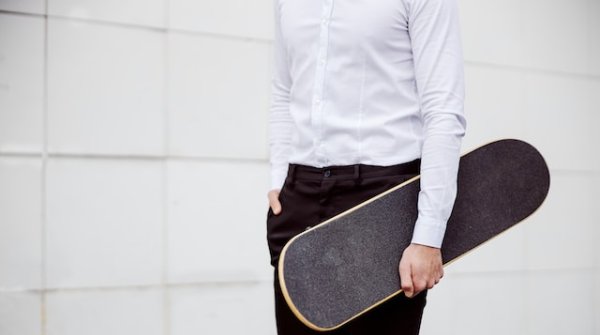A clothing bargain at the flea market or an old blouse from Aunt Christine - selling or inheriting used clothing is probably as old as clothing itself. Online marketplaces such as ebay, founded in 1995, have made the exchange of goods even more convenient. However, second-hand clothing has only experienced a real commercial growth spurt since ecological awareness has reached the center of society. For a few years now, this has also given the second-hand market for outdoor and sporting goods a real boost.
Overall, Global Data estimates in a study for the second-hand marketplace ThredUp Global Data puts the forecast global sales volume for second-hand fashion at 350 billion dollars for 2028. In 2023, the market volume was 197 billion dollars. Growth is driven in particular by Gen Z, 71% of whom like to buy worn outfits, compared to just 63% of the population as a whole, according to the survey.
Zalando is also exploiting this potential. The marketplace has been the first European fashion platform to offer second-hand goods since 2020. Although Zalando does not reveal how much turnover the retailer makes with second-hand fashion when asked by ISPO.com, it is particularly the 18 to 29-year-olds who use the offer. Since 85 percent of Zalando customers exercise at least once a week, this is also an attractive category in the second-hand sector, according to the company.
Decathlon also benefits from this. In contrast to Zalando, the sports and outdoor giant from France is willing to provide information about its figures in this segment. In 2023, Decathlon Germany sold more than 64,000 used products via the Second Use service. According to Decathlon United the Group generated around 420 million euros globally in 2023 with circular business models (Second Life, Repair & Care, Buy Back, Rent).
Specialists in the sports and outdoor market have also followed suit on the retailer and brand side, for example Bergzeit. Project manager Jens Oellrich says: " Bergzeit RE-USE was launched on June 1, 2022, and sales of used outdoor clothing, equipment and footwear have currently increased fivefold [compared to three months after the launch, the editorial team]. We even expect to grow even faster in the coming months." Bergzeit currently has around 8,000 used items available in the store, "most of which come from private individuals (approx. 65%). Bergzeit returns and goods from manufacturers, such as sample items, complete the range," says Oellrich. He estimates the potential for the coming years to be high, as a young target group in particular is interested in used goods.
Vaude only recently entered the second-hand market. 500 items of clothing were on offer at the opening. "Clothing is by far our most popular and best-selling product category," says Robert Klauer, who is responsible for circular business development at Vaude. "It therefore makes sense to start with this, as we can offer relevant quantities here. In the next step, we also want to sell used products from the rental service. This mainly involves hardware such as tents, sleeping bags and sleeping mats." As with Bergzeit, the declared aim is to extend the life cycle of the products and establish a circular business model.

The outdoor brand Rab relies on sales at specialist retailers and only secondarily on D2C. The Second Stitch program, which has been in place in the UK since 2019, sells "repaired warranty products that we have refunded due to age or damage. Returns from retailers are also sold through Second Stitch, and we make new products/items from factory remnants," says PR & Communications Manager Europe Sarah Kampf. "The Second Stitch products offered in our factory outlet sell incredibly quickly, often on the same day they are laid out." In 2023, 568 individual items were sold in the UK.
Patagonia also has many years of experience with reselling, particularly in the USA. In Germany, there has been a pilot project in Berlin since 2022. In the USA, 33,015 kilograms of used clothing were sold in 2021, Patagonia employee Birgit Großmann told Sporting Goods Intelligence Europe.
In March 2024, the Patagonia team organized a pop-up store in Amsterdam for one day. The store only sold second-hand clothing that had been repaired by the United Repair Center Amsterdam. All proceeds from the day, more than 33,000 euros, were donated directly to four NGOs a in the Netherlands.
In addition to the brands and retailers mentioned, there are many other examples such as Maloja, which has set up a Preloved Corner in its stores, and Globetrotter. The outdoor specialist has been selling second-hand goods online and in stores since 2020.
One of the major differences between clothing sold directly between end customers and sales via brands or retailers is product control, preparation and care by the store. This also explains the higher price. Which brings us to the biggest challenges in the second-life game in the fashion industry.

But how much should used clothing cost? The process of determining the price is not that simple. The selling price of the first owner, the cost of reconditioning and the distribution costs have to be taken into account. The condition of the product must also be assessed. Second-hand service provider reverse.supply has developed its own software for this purpose. This takes into account the price at which the brand's products are sold on competitor platforms and how successful the sale is. Brand desirability is therefore a major factor in pricing.
In addition to pricing, the entire logistics is a complex process that is usually handled by a third-party provider. Vaude relies on WKS Textilveredelungs-GmbH. Among other things, it divides the products into three quality levels. Like Decathlon, Ortovox, Sport Scheck and Globetrotter, Bergzeit uses reverse.supply. According to Bergzeit, the service provider handles all "technical and operational processes in the background, such as price management, refurbishment, product data creation and fulfillment processes".
This means that, among other things, the refurbishment of the goods, photos, description, picking and storage are carried out by the service provider.
Of course there are lots of second-hand items. But good items from high-quality brands are still a scarce commodity. Mick Austermühle, Manager Central Europe Patagonia, explains that the main problem with reselling is the lack of goods. In the USA, vintage fashion pieces from the brand are sold out after just a few days.
Cam McGimpsey wants to solve this problem. He is co-founder of Birl. The company offers online stores and their customers the opportunity to return used clothing during the purchasing process and receive discounts on new purchases. Birl handles logistics and resale for the online store. The first customer for the SaaS start-up is British jacket supplier Lavenham.
Conclusion: In addition to the new habit of buying a used item of clothing from time to time, the habit of returning used clothing must also become established.
 SustainabilityWhy the sports world is putting greenwashing aside first
SustainabilityWhy the sports world is putting greenwashing aside first







